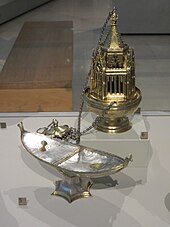Whittlesey Mere
The mere was a source of fish, wildfowl, reed and sedge for local inhabitants, and also provided a setting for 'water picnics' for the region's nobility.
The ground is all wett and marshy but there are severall little Channells runs into it which by boats people go up to this place; when you enter the mouth of the Mer it looks formidable and its often very dangerous by reason of sudden winds that will rise like Hurricanes...."[2] Before drainage, the fens contained many shallow lakes, of which Whittlesey Mere was the largest.
[6] The project was funded by a group of gentlemen and local landowners: William Wells of Holmewood; Heathcote of Conington Castle; Edward Fellowes of Ramsey Abbey; Thornhill of Diddington; Lord Sandwich; and Wentworth Fitzwilliam of Milton.
[12] The name 'Whittlesea Mere' remains on maps to this day, although the only water is to be found in farmers' irrigation reservoirs and dykes draining the fertile farmland.
Stage 3 of the Great Fen Project may eventually see the mere return to wetland,[13] although the lake bed is now higher than the former shoreline due to the uneven shrinkage of the surrounding peat as it has dried.
Obscured from view, he remained stuck for 19 hours, which he ascertained from the sound of the bells of All Saints Church, Conington, until a fellow villager found him by chance, extricated him and returned him to his parents.




